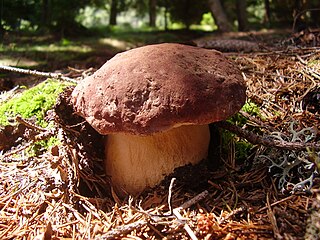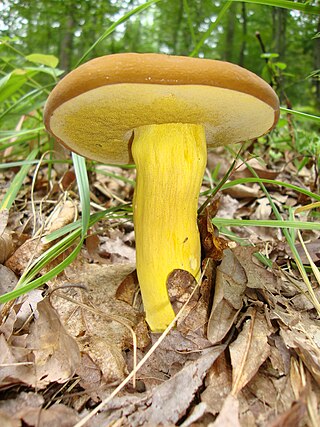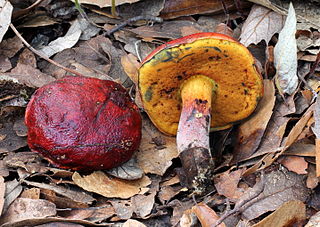
The Boletales are an order of Agaricomycetes containing over 1300 species with a diverse array of fruiting body types. The boletes are the best known members of this group, and until recently, the Boletales were thought to only contain boletes. The Boletales are now known to contain distinct groups of agarics, puffballs, and other fruiting-body types.

Boletus edulis is a basidiomycete fungus, and the type species of the genus Boletus. Widely distributed in the Northern Hemisphere across Europe, Asia, and North America, it does not occur naturally in the Southern Hemisphere, although it has been introduced to southern Africa, Australia, New Zealand, and Brazil. Several closely related European mushrooms formerly thought to be varieties or forms of B. edulis have been shown using molecular phylogenetic analysis to be distinct species, and others previously classed as separate species are conspecific with this species. The western North American species commonly known as the California king bolete is a large, darker-coloured variant first formally identified in 2007.

The Boletaceae are a family of mushroom-forming fungi, primarily characterised by small pores on the spore-bearing hymenial surface, instead of gills as are found in most agarics. Nearly as widely distributed as the agarics, the family is renowned for hosting some prime edible species highly sought after by mushroom hunters worldwide, such as the cep or king bolete . A number of rare or threatened species are also present in the family, that have become the focus of increasing conservation concerns. As a whole, the typical members of the family are commonly known as boletes.

Boletus is a genus of mushroom-producing fungi, comprising over 100 species. The genus Boletus was originally broadly defined and described by Carl Linnaeus in 1753, essentially containing all fungi with hymenial pores instead of gills. Since then, other genera have been defined gradually, such as Tylopilus by Petter Adolf Karsten in 1881, and old names such as Leccinum have been resurrected or redefined. Some mushrooms listed in older books as members of the genus have now been placed in separate genera. These include such as Boletus scaber, now Leccinum scabrum, Tylopilus felleus, Chalciporus piperatus and Suillus luteus. Most boletes have been found to be ectomycorrhizal fungi, which means that they form a mutualistic relationship with the roots system of certain kinds of plants. More recently, Boletus has been found to be massively polyphyletic, with only a small percentage of the over 300 species that have been assigned to Boletus actually belonging there and necessitating the description and resurrection of many more genera.

Baorangia bicolor, also known as the two-colored bolete or red and yellow bolete after its two-tone coloring scheme of red and yellow, is an edible fungus in the genus Baorangia. It inhabits most of eastern North America, primarily east of the Rocky Mountains and in season during the summer and fall months but can be found across the globe in China and Nepal. Its fruit body, the mushroom, is classed as medium or large in size, which helps distinguish it from the many similar appearing species that have a smaller stature. A deep blue/indigo bruising of the pore surface and a less dramatic bruising coloration change in the stem over a period of several minutes are identifying characteristics that distinguish it from the similar poisonous species Boletus sensibilis. There are two variations of this species, variety borealis and variety subreticulatus, and several other similar species of fungi are not poisonous.

Boletus pinophilus, commonly known as the pine bolete or pinewood king bolete, is a basidiomycete fungus of the genus Boletus found throughout Europe and western Asia. Described by Italian naturalist Carlo Vittadini in 1835, B. pinophilus was for many years considered a subspecies or form of the porcini mushroom B. edulis before genetic studies confirmed its distinct status. In 2008, B. pinophilus in western North America were reclassified as a new species, B. rex-veris. B. pinophilus is edible, and may be preserved and cooked.

Xerocomus subtomentosus, commonly known as suede bolete, brown and yellow bolete , boring brown bolete or yellow-cracked bolete, is a species of bolete fungus in the family Boletaceae. The fungus was initially described by Carl Linnaeus in 1753 and known for many years as Boletus subtomentosus. It is edible, though not as highly regarded as other bolete mushrooms.

Exsudoporus frostii, commonly known as Frost's bolete or the apple bolete, is a bolete fungus first described scientifically in 1874. A member of the family Boletaceae, the mushrooms produced by the fungus have tubes and pores instead of gills on the underside of their caps. Exsudoporus frostii is distributed in the eastern United States from Maine to Georgia, and in the southwest from Arizona extending south to Mexico and Costa Rica. A mycorrhizal species, its fruit bodies are typically found growing near hardwood trees, especially oak.
Boletus pseudofrostii is a species of bolete fungus in the family Boletaceae. Found in Belize, it was described as new to science in 2007.
Boletus neotropicus is a species of bolete fungus in the family Boletaceae. Found in Belize, it was described as new to science in 2007.
Boletus occidentalis is a species of bolete fungus in the family Boletaceae. Found growing under Pinus occidentalis in Jarabacoa, Dominican Republic, it was described as new to science in 2007.
Boletus projectelloides is a species of bolete fungus in the family Boletaceae. Found in Belize, it was described as new to science in 2007.
Boletus roseoareolatus is a species of bolete fungus in the family Boletaceae. Found in Belize, it was described as new to science in 2007.
Boletus brunneotomentosus is a species of bolete fungus in the family Boletaceae. Found in Belize, it was described as new to science in 2007.
Boletus rugulosiceps is a species of bolete fungus in the family Boletaceae. Found in Belize, it was described as new to science in 2007.

Boletus auripes, commonly known as the butter-foot bolete, is a species of bolete fungus in the family Boletaceae. First described from New York in 1898, the fungus is found in eastern Asia, Central America, and eastern North America from Canada to Florida. It is a mycorrhizal species and typically grows in association with oak and beech trees.

Imperator torosus, commonly known as the brawny bolete, is a species of bolete fungus in the family Boletaceae. It is native to southern Europe east to the Caucasus and Israel. It is generally associated with deciduous trees such as hornbeam, oak and beech in warm, dry locales. Although generally rare in Europe, it appears to be relatively common in Hungary. Appearing in summer and autumn on chalky soils, the stocky fruit bodies have an ochre cap up to 20 cm (8 in) across, yellow pores on the cap underside, and a wine-red to brown or blackish stipe up to 6–15 cm (2.4–5.9 in) long by 3–6 cm (1.2–2.4 in) wide. The pale yellow flesh changes to different colours when broken or bruised depending on age; younger mushrooms become reddish, and older ones additionally take on bluish tones.

Rubroboletus dupainii, commonly known as Dupain's bolete, is a bolete fungus of the genus Rubroboletus. It is native to Europe, where it is threatened, and red listed in six countries. It also occurs in North America, although it is rare there. It was first recorded from North Carolina, and then from Iowa in 2009. It was reported from Belize in 2007, growing under Quercus peduncularis and other oaks.

Boletus subluridellus is a species of bolete fungus in the family Boletaceae. Described as new to science in 1971 by American mycologists, the bolete is found in the eastern United States and Canada. It grows on the ground in coniferous and mixed forests in a mycorrhizal association with deciduous trees, especially oak. The fruit bodies (mushrooms) have orangish-red, broadly convex caps that are up to 10 cm (3.9 in) in diameter, with small, dark reddish pores on the underside. The pale yellow stipe measures 4–9 cm (1.6–3.5 in) long by 1.5–2.3 cm (0.6–0.9 in) thick. All parts of the fruit body will quickly stain blue when injured or touched.











